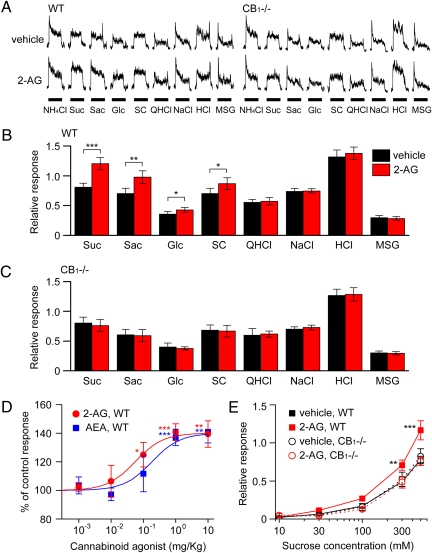Fig. 1.
Endocannabinoids enhance gustatory nerve responses to sweeteners. (A) Typical examples of CT nerve responses of WT and CB1−/− mice showing the effect of i.p. injection of 1 mg/kg bw of 2-AG (Lower traces) vs. vehicle-injected control (Upper traces). CT nerve responses (normalized to response to 100 mM NH4Cl) of WT (B) and CB1−/− (C) mice stimulated by sweet (Suc, 500 mM sucrose; Sac, 20 mM saccharin; Glc, 500 mM glucose; SC, 1 mM SC45647), bitter (QHCl, 20 mM quinine-HCl), salty (NaCl, 100 mM NaCl), sour (HCl, 10 mM HCl), and umami (MSG, 100 mM monosodium glutamate + 10 μM amiloride) compounds 10–30 min after administration of vehicle (black bars) or 1 mg/kg bw of 2-AG (red bars) (n = 5–10). (D) Dose-dependent effect of AEA (blue symbols) or 2-AG (red symbols) treatment on normalized chorda tympani nerve responses to 500 mM sucrose (n = 5–14). (E) Concentration-dependent responses to sucrose 10–30 min after administration of vehicle (black symbols) or 1 mg/kg bw of 2-AG (red symbols) in WT (squares) (n = 7) and CB1−/− (circles) mice (n = 5). Asterisks indicate significant differences from control (*P < 0.05; **P < 0.01; ***P < 0.001; Fisher’s PLSD post hoc test or t test). All data are presented as the mean ± SEM.

